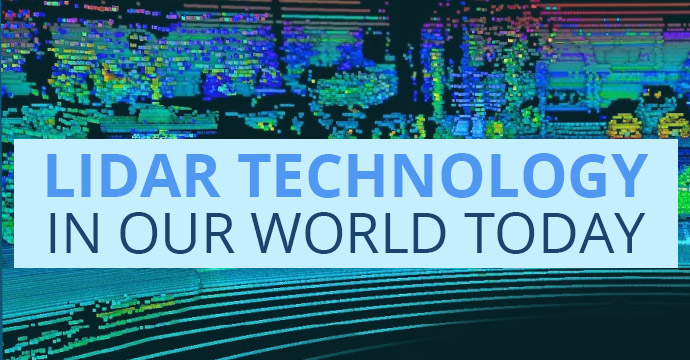
LiDAR technology is developing fast, which is illustrated by the number of start-up companies to serve the autonomous market. Everything from traditional mechanical scanning devices, tiny-chip solid-state LiDAR units, LiDAR in automobiles and even your household robot vacuum. The fact that now you can get an Apple device with LiDAR in it indicates this technology’s arrival in the public domain. Even just a few decades ago, it was difficult to explain our industry. Now, many consumers are familiar with the word, “LiDAR”!
What is LiDAR Technology?
LiDAR is a method for determining ranges by targeting an object with a laser and measuring the time for the reflected light to return to the receiver. The word LiDAR stands for Light Detection and Ranging.
Most people think LiDAR is a “new” technology and only been around for the last decade or two but, it dates all the way back to the 1960s! It started to gain some popularity and more use cases back in the 1980s with the introduction of GPS. It was used to calculate accurate geospatial measurements.
Today, you can find it in your day-to-day routines. From using your phone to driving down the street and seeing the Waymo vehicles all decked out with LiDAR scanners on them, LiDAR is everywhere!
LiDAR in the World Today
Let’s focus on LiDAR outside the typical terrestrial and aerial LiDAR that we are all used to seeing or reading about. They are the backbone of the industry, but the emergence of LiDAR in everyday consumer products and autonomous vehicles is what I would like to focus on.
As you read this article, did you know you can 3D map your house without using an extremely expensive tripod scanner? Or that you could “take a picture” using your phone or tablet and bring that into a project as a 3D model? That is correct. LiDAR has worked its way into our everyday lives.
LiDAR-Based Robot Vacuums
You can now purchase robot vacuums that have small LiDAR cameras on them. With this added technology, it has taken what was once almost a comedy reel waiting to happen – your robot vacuum just randomly bounced off objects in your house, to now – it is a precise vacuuming fighter jet on the hunt for any dirt to destroy!
Robot vacuums are using LiDAR for navigation and obstacle avoidance. Vacuums from brands like Wyze and Roborock, for example, can actually identify the kinds of obstacles they encounter (like differentiating a shoe from a child’s toy) and better navigate around them. They take a 3D model of your house and use that as a floor plan to navigate around. Knowing where walls and obstacles are better help it vacuum your house without missing a spot.

Autonomous Vehicles
In automotive applications of the LIDAR technology, most of the LIDAR sensors are installed on the top of the vehicle. LIDAR Sensors continuously rotate and generate thousands of laser pulses per second. These high-speed laser beams from LIDAR are continuously emitted in the 360-degree surroundings of the vehicle and are reflected by the objects in the way.
With use of complex machine learning algorithms, the data received through this activity is converted into real-time 3D graphics, which are often displayed as 3D images or 3D maps of the surrounding objects. All that information is used for obstacle avoidance in autonomous vehicles.

Conclusion
To quote Abraham Lincoln: “The most reliable way to predict the future is to create it.” LiDAR has come a long way since the 1960s. In the last 20 years alone, it has taken off! I am excited to see what the next decade has in store for us!
This blog is written by Reality Capture Technical Specialist Josh Hunter.
Behind the Blog: Meet Josh Hunter

Josh has over 12 years of sales experience in the telecommunications field. With a real passion for technology, Josh came to ATG looking for a new adventure in the AEC world. He started in sales and then transitioned to the Reality Capture team, quickly becoming a certified drone pilot and laser scanning technician.
He now uses his sales and technical expertise to help deliver new cutting-edge solutions to AEC professionals to help increase productivity and win more jobs in the ever-changing world of technology.
MEP Services and Resources
Stay Connected
Follow ATG for 24/7 access to top-notch technical content:
Have questions? Don’t hesitate to reach out!
- Contact us
- Call 1.800.935.4894